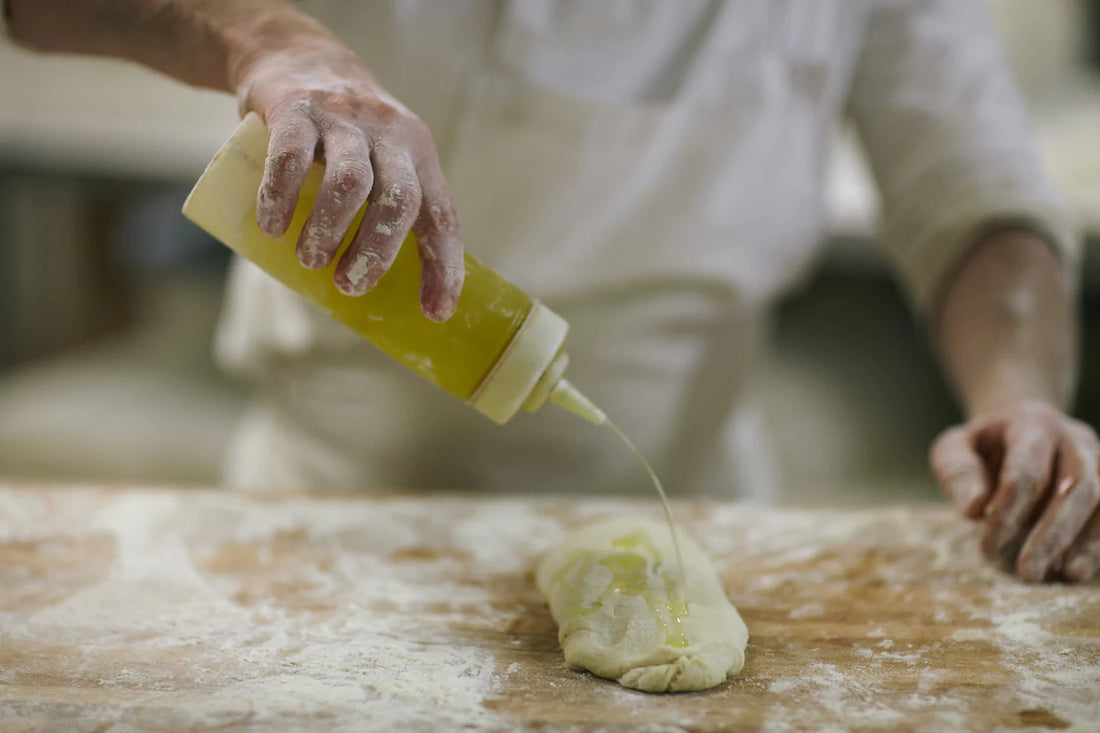Adding oil to your pizza dough makes it crispier once baked.
The oil creates an impermeable layer that moisture, such as that present in tomato sauce, cannot easily penetrate. In other words, olive oil in pizza dough prevents sauce from absorbing into the dough and making it floppy.
If you end up with a softer, floppier pizza, there’s a good chance the dough contains little or no oil. Many classic pizza dough recipes do not include any, such as that of a traditional Neapolitan pizza pie.
While the options of what olive oil to add to pizza dough are numerous, if you’re just starting out, keep things simple with a recipe like the one described here.
Types of olive oil
As you hone your skills as a pizzaiolo, you may want to experiment with different types of olive oil in your pizza dough recipe.
You’ll notice that there are numerous options to choose from. Labels describe olive oil according to its designation.
For example:
- Extra virgin olive oil (EVOO) is considered the best quality and most flavorful. It has been found to have no defects and tends to be the most expensive.
- Virgin olive oil is a good quality oil that doesn’t necessarily meet the same standard of perfection as EVOO. It does however have the benefit of being less expensive.
- Refined olive oil is more highly processed than extra virgin and virgin olive oils and, as a result, has almost no taste or smell. However, what it lacks in flavor it makes up for in function, because it can be easily blended with other oils.
While olive oil is produced in many parts of the world, if you’d like to use an authentic Italian olive oil in your pizza dough, look for a ‘Made in Italy’ stamp on the label rather than one stating that it was only ‘Bottled in Italy’.

Olive oil, like wine, gets its flavor from the region where its fruits were grown; as with grapes in a vineyard, the terroir, or land where an olive grove is based, will influence how an oil tastes.
Unlike wine, however, it does not improve over time. Freshness is an essential quality to any good olive oil. Though many cooks think of it as long-lasting, olive oil has a shelf life of about three months. If it starts to smell like that of crayons or putty, it has likely gone bad.
Other oils that work well with pizza dough
Dough will assume the flavor contained in the oil that it’s made with.
If you’re keen to try some new dough flavors, we recommend the following oils:
- Asian-Inspired Pizza: Sesame oil will add a toasted flavor to your dough. It can be quite strong so consider blending it with another, less flavorful oil.
- Indian-Style Pizza: Consider replacing the oil in a traditional Italian pizza dough recipe with melted ghee. Adding ground Indian spices and/or chopped cilantro are an easy way to lend authentic Indian flavors to the meal.
- Dessert Pizza: Look for a neutral oil such as canola or grape seed oil for dessert pizzas. To heighten the taste of your toppings, consider infusing the oil with a popular spice like cinnamon.
- Herbaceous Pizza: Add subtle flavors to your dough with an herb-infused olive oil. For example, spices and chilies work well in olive oil, and help to expand the flavor profile of your pie.
To ensure consistent results and taste, many restaurants that serve pizza rely on blended olive oil for their pizza dough recipes. If you enjoy pizza at a restaurant in part because it always tastes the same, chances are the recipe includes a blended oil.
The important role that oil can play in pizza dough is undeniable. However, it can also be a great condiment. To lock in the crunch of your crust, brush a tasty extra virgin olive oil on your pizza before applying any toppings that will work to soften it.
Pro-tip: Allow dough to hydrate
While oil in pizza dough has a tenderizing effect, making it easier to shape and work with, it can also be problematic, interacting with any water the dough contains. The result? An overly watery pizza that’s difficult to shape.
For dough with an ideal structure, we recommend a simple two-step approach:
- Combine the flour and water, and, let sit for a about 15 minutes
- Add oil
This approach, known as the autolyse method, allows time enough for the water to hydrate the flour. Enzymes in the water start to break down proteins and starches in the dough, helping gluten develop.

To give it a try, combine the flour and water and mix at a low speed.
If you’re without a mixer and working by hand, know that kneading the pizza dough by hand will take considerably longer. While many cooks worry about over kneading by hand, it’s unlikely to happen.
When you’re ready to start working with the dough, flour your work station.
Be aware that adding flour at any stage, beyond what’s called for in the recipe, can reduce dough hydration. With that in mind, consider measuring all the flour you’re going to use beforehand.
Pizza dough is best when it's fresh, so we recommend stretching, topping, baking, and enjoying it as soon as the dough is made.


